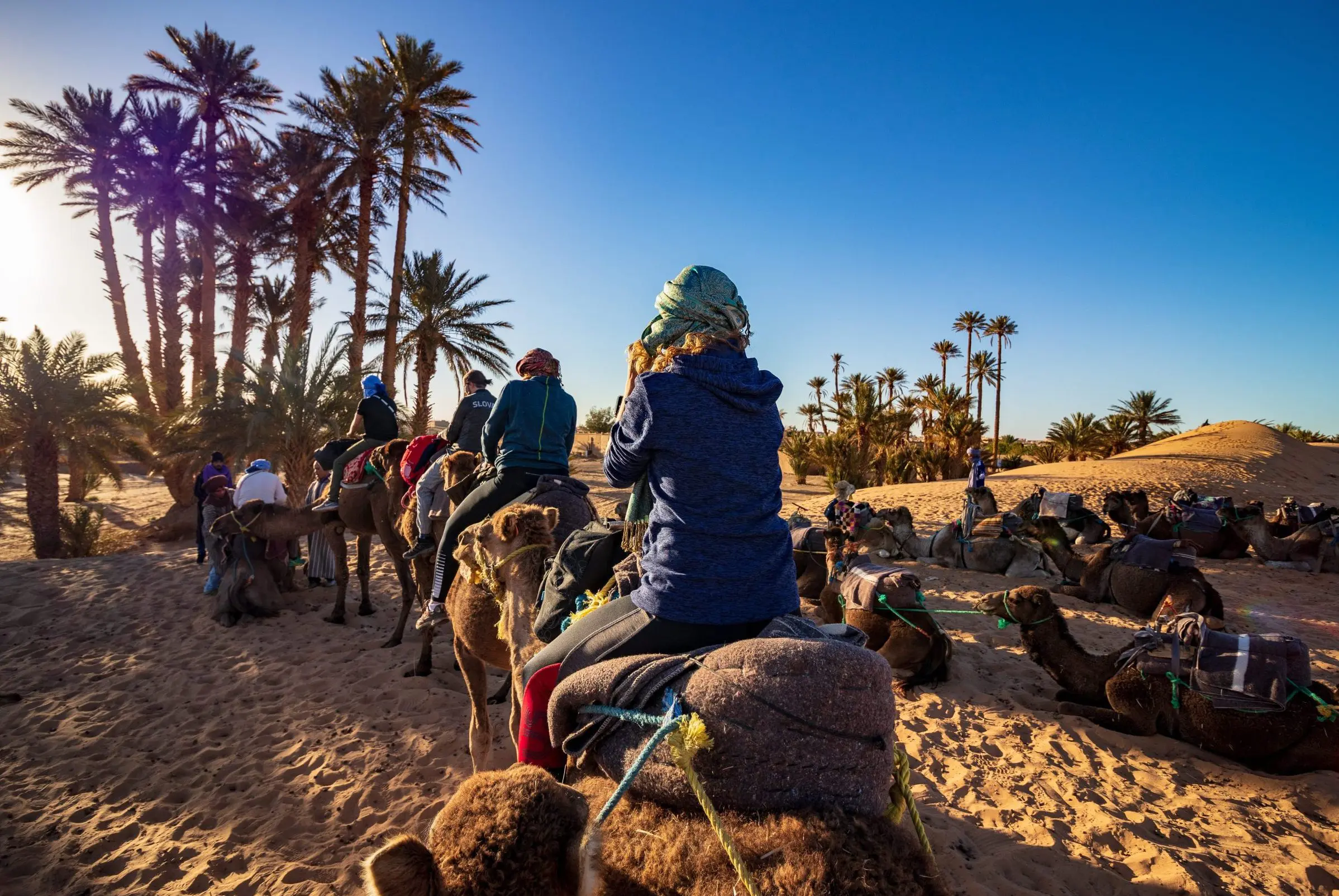Location of Atacama Desert
Spanning from southern Peru to northern Chile, the Atacama Desert stands out as a premier tourist destination in the region. Positioned to the west of the Andes Mountain range, this 1,600km expanse boasts an extraordinary landscape along the Pacific coast. Discover here the compelling reasons that make the Atacama Desert so captivating
Recommended:
Here are the 10 Facts about Atacama Desert

1. The Driest place on Earth – Atacama Desert

The Atacama Desert is one of the driest places on Earth besides the polar deserts. The desert is located by the Andes Mountains which subsequently blocks rainfall in the area. The Pacific Ocean to the West of the Atacama Desert also hinders the formation of clouds and consequently rain. As a result, the Atacama Desert is as dry as a bone.
2. Cold Desert

The term ‘cold desert’ seems oxymoronic, however the characteristic of a desert doesn’t necessarily fall on the blistering heat. The average temperature of the site ranges from 0 °C to 30 °C. Whilst it’s normal deserts drop in temperature at the night, the Atacama desert retains its cooler temperature throughout the day due to the influx of cold ocean air.
The Purple Desert

Every couple of years, parts of Atacama Desert’s recognisable orange landscape will transform into a vibrant purple hue. Not much life is able to survive in the desert, but these purple flowers sprout during the spring time and depend on the small percentage of rainfall that the region receives. Visitors marvel at the flowers not only for its beauty but for the resilience of life even in driest of places. In addition to purple, the hills will also turn yellow, white and blue from the persisting plant life. Unfortunately, this flower display is threatened by global warming and human disruption.
Mummified Birds
In 2021, a study was completed that analysed 27 mummified parrots discovered in the Atacama Desert. The parrots, that included macaws and amazon parrots, were found skeletal and mummified without it’s feathers. Researchers believe that these parrots were made captive and transported from the Amazon Rainforest to the area centuries before.
During pre-Columbian Chile, tropical parrots were a symbol of wealth and prestige. The people of the era would have used the bird’s bright plumage for a range of uses, including headdresses that would’ve been a sign of leadership.
Mano del Desierto (The Desert Hand)

The giant hand sits east from the city of Antofagasta, reaching to the heavens under the desert earth. Chilean sculptor Mario Irarrazabal constructed this statue as a symbolic representation of previous human right violation faced by Chileans. On a land as ruthless and devoid of life as the Atacama Desert, it is inspiring to see art incorporated into the landscape. You can find it on Route 5 on the Pan-American Highway.
Mars expedition simulations

If you’ve ever wanted to visit space but you’re lacking the net-worth of Jeff Bezos, the Atacama Desert might be the next best thing. The rich, orange sand and seemingly endless mountain range gives an otherworldly experience that can’t be found anywhere else on Earth.
The Atacama Desert isn’t only used to inspire the imagination. It is also used by scientists as a simulator in preparation for real expeditions to Mars.

Human Attraction toward Atacama Desert

Surprisingly, the Atacama Desert attracts business and human activity. A degree of farming has been achieved in proximity to the desert’s sparse oasis’ and across the centuries the desert has been used for trade, farming and mining. Today many people hit the desert for hiking and sports events are held at the dunes such as sand boarding, rallying and foot racing.
War of the Pacific

The Atacama Desert is mineral rich and consequently has been the subject of conflict. The War of the Pacific took place between 1879-83 and involved Chile, Peru and Bolivia. It fell in Chile’s favour by its conclusion in 1883 and is now one of Chile’s main sources of wealth.
Road trips around Atacama Desert

The Atacama Desert might be barren land, but that doesn’t mean it isn’t well connected and full of diverse scenery. As well as being massively useful to locals, the roads mean travellers can experience road trips that rival Route 66. In one trip you can experience The Valley of the Moon, Altiplanic Lagoons and Reserva Nacional Los Flamencos.
Atacama Astrology Hotspot

Largely considered the one of best spots for astrologers, the lack of human life and rainfall in the area mean the skies are pollution free, cloud free and yours to admire. The Milky Way Galaxy is visible from the desert and attract a number of telescope and observatories. Advanced science is used in the area to spy on stars thousands of light years away. ALMA ( Atacama Large Millimeter/submillimeter Array) observatories is one of the biggest in the area. Observatories are open for tourists once a week and is an experience you won’t be able to forget.
Check out our Peru tours to find out more about Peru’s incredible sites!
Best Time to Visit Atacama Desert

- Summer: High season with warmer temperatures, potential crowds, and a mention of the rainy season.
- Autumn: Cooler temperatures, low season with good deals, and opportunities for wine tours during the harvest.
- Winter: Clear skies for stargazing, lower temperatures at night, potential snowfall affecting trips to higher altitudes, and a mention of winter holidays in July.
- Spring: Windy months, especially in October, but still a good time to visit before the onset of summer.
In summary, Atacama Desert is attractive to visit throughout the year, but they provide additional details and nuances regarding each season. Your choice of when to visit may depend on your preferences for weather, crowd levels, and specific activities like stargazing or wine tours. If you prefer milder temperatures and fewer crowds, the fall (March to May) seems to be a consensus recommendation.
Frequently Asked Questions About Atacama Desert
The Atacama Desert has an extremely arid climate, making it one of the driest places on Earth. It is characterized by very low precipitation and high evaporation rates. The average annual rainfall in most parts of the Atacama Desert is minimal, often measuring just a few millimeters or less. Some weather stations within the desert have reported years with no measurable rainfall.
The desert’s aridity is attributed to several factors, including the presence of the cold Humboldt Current offshore, which cools the air and reduces its moisture-carrying capacity, and the rain shadow effect caused by the Andes Mountains to the east, which block moisture-laden air masses from the Amazon Basin.
Despite its extreme aridity, the Atacama Desert exhibits temperature variations based on factors such as altitude and proximity to the coast. Coastal areas generally experience milder temperatures, while higher-altitude regions can be cooler. Additionally, the Atacama Desert is known for its clear skies, low humidity, and high daytime temperatures, along with significant temperature drops during the night.
When visiting the Atacama Desert, especially the town of San Pedro de Atacama, you’ll find various souvenirs and local products that reflect the culture and environment of the region.
Here are some items you might consider buying:
Alpaca Wool Products: The Andean region is known for its alpacas, and you can find items made from alpaca wool, such as scarves, blankets, sweaters, and hats.
Handicrafts and Artisanal Items: Local artisans in San Pedro de Atacama produce a variety of handicrafts, including pottery, textiles, and jewelry. Look for unique pieces that showcase the traditional techniques and designs of the area.
Pisco: Pisco is a grape brandy that is popular in Chile and Peru. You might find local varieties or souvenirs related to pisco production in the region.
Llama and Vicuña Products: Similar to alpaca, llama and vicuña wool are used to create textiles and clothing items. Vicuña wool, in particular, is highly prized for its softness and quality.
Local Foods: You can explore local markets to find traditional Chilean foods and spices. This might include products like dried fruits, native herbs, and even local chocolates or candies.
Photography: Given the stunning landscapes of the Atacama Desert, consider purchasing photographic prints or books featuring images of the unique geological formations, salt flats, and other natural wonders.
Minerals and Gemstones: The Atacama Desert is rich in minerals. You may find shops selling gemstones and minerals, including items like lapis lazuli, which is a semi-precious stone found in the region.
Yes, there are places to stay near the Atacama Desert, particularly in the town of San Pedro de Atacama, which is a popular base for visitors exploring the desert and its surrounding attractions. San Pedro de Atacama is located in the northern part of Chile, near the Atacama Desert.
In San Pedro de Atacama, you’ll find a range of accommodation options to suit different preferences and budgets. These include hotels, hostels, guesthouses, and boutique lodges. Many of these establishments cater to tourists who come to explore the unique landscapes and geological formations of the Atacama Desert, such as the Valle de la Luna (Valley of the Moon), geysers, salt flats, and more.
It’s advisable to book your accommodation in advance, especially during peak tourist seasons. San Pedro de Atacama has become a popular destination, and having a place to stay secured in advance can help ensure a smoother travel experience.
The Atacama Desert is known for its extreme aridity, and it is one of the driest places on Earth. In some areas of the Atacama, there are years where no measurable rainfall occurs. On average, annual precipitation in the Atacama Desert is minimal, often ranging from a few millimeters to around 50 millimeters (about 2 inches) per year. However, these values can vary depending on the specific location within the desert.
Coastal areas may receive slightly more precipitation than the inland regions, and higher-altitude areas may also experience some variation in rainfall. The arid conditions in the Atacama Desert are primarily due to the rain shadow effect caused by the Andes Mountains, the influence of the cold Humboldt Current along the coast, and the overall atmospheric conditions in the region.
The Atacama Desert is exceptionally dry due to a combination of geographical and climatic factors:
Rain Shadow Effect: The Atacama Desert is located on the western side of the Andes Mountains. As moist air masses move from the east (Amazon Basin) towards the mountains, they are forced to rise. As the air rises, it cools, and its moisture condenses and falls as precipitation on the eastern side of the Andes.
By the time the air descends on the western side (where the Atacama Desert is situated), it has lost much of its moisture, creating a rain shadow effect. This means that the western side of the Andes, including the Atacama Desert, receives very little rainfall.
Cold Humboldt Current: The cold Humboldt Current flows along the western coast of South America. This current cools the air over the Pacific Ocean, reducing its ability to hold moisture. As this cool, dry air moves inland, it contributes to the aridity of the Atacama Desert.
High-pressure Systems: The desert is under the influence of high-pressure systems, which further inhibit the formation of clouds and precipitation.
Latitude and Elevation: The Atacama Desert is located at a high latitude and includes high-altitude plateaus. These factors contribute to cooler temperatures and lower humidity, limiting the potential for moisture in the air to condense and form precipitation.
The combination of these factors results in an extremely arid climate, making the Atacama Desert one of the driest places on Earth. The unique conditions in this desert have led to its use as an analog for Mars, with researchers studying the region’s extreme dryness and harsh environmental conditions to gain insights into the possibilities of life on the Red Planet.
The Atacama Desert is located in northern Chile, and reaching it typically involves flying to the nearest major airport and then traveling overland to the specific town of San Pedro de Atacama, which serves as a popular gateway to the desert. Here are the general steps to get to the Atacama Desert:
Step 1: International Flight to Santiago, Chile
Most international travelers will fly into Santiago, the capital city of Chile. Santiago has the largest international airport in the country, Comodoro Arturo Merino Benítez International Airport (SCL). From Santiago, you have several options to reach the Atacama Desert.
Step 2: Connecting Flight to Calama
The nearest airport to the Atacama Desert is El Loa Airport (CJC) in Calama. You can take a domestic flight from Santiago to Calama. Flights are available from various airlines, and the journey takes around two hours. Calama is the closest major town to San Pedro de Atacama.
Step 3: Overland Transfer to San Pedro de Atacama
From Calama, you can arrange for ground transportation to San Pedro de Atacama, which is approximately 100 kilometers (about 62 miles) away. Options for transportation include buses, shared shuttles, or private transfers. The journey usually takes around 1 to 1.5 hours, depending on the mode of transportation.
Alternative Route: Direct Flights to Calama
Some international flights may have the option of landing directly in Calama, bypassing the need for a connecting flight through Santiago. However, these options may be limited, and flights to Santiago are generally more widely available.
Travel Tips:
Book Flights in Advance: To secure the best rates, it’s advisable to book your international and domestic flights in advance.
Altitude Considerations: San Pedro de Atacama is at a high altitude, so it’s essential to acclimate gradually. Spend a day or two relaxing in San Pedro before engaging in strenuous activities.
Transportation Options: Depending on your budget and preferences, you can choose between buses, shared shuttles, or private transfers from Calama to San Pedro de Atacama.
Always check current travel regulations, flight availability, and local conditions before planning your trip, as circumstances may change.
 October Sale: 50% Off
October Sale: 50% Off Croatia Sailing 2025: 50% Off
Croatia Sailing 2025: 50% Off ANZAC Day Trips : Save 40%
ANZAC Day Trips : Save 40%  Central & Eastern Europe Tours: 50% Off
Central & Eastern Europe Tours: 50% Off  Why Travel Talk
Why Travel Talk Travel Talk Blog
Travel Talk Blog Responsible Travel
Responsible Travel Fair Travels with Travel Talk
Fair Travels with Travel Talk




